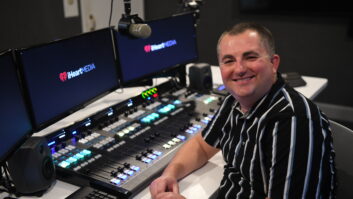The authors are president and vice president, respectively, of Communications Technologies Inc., a consultancy in Marlton, N.J.

Fig. 1: Measured vertical (purple) and horizontal (blue) field strength patterns for omnidirectional antenna. The antenna was face-mounted on a four-foot-wide tower section with no compensation for the effects of the tower mount. The full-scale 100 percent signal is the outer graph ring and can be calibrated to show predicted field strength at various powers. There are multiple motivations for this paper. First and foremost is the fact that the FCC is in the process of authorizing hundreds of new FM translator stations and is expected to authorize hundreds, if not thousands, of LPFM new facility authorizations in 2014. This level of activity, combined with the ongoing installation of new and replacement high-power FM antennas, is expected to develop an unprecedented demand for FM antenna products. Past client experiences demonstrate the importance of choosing an antenna system that truly meets the client’s needs.
EXPECTATIONS AND ANALYSIS
Recently, a highly respected client with whom we have worked for years made the statement that he had never bought a commercial FM station with a directional antenna, believing such a station to be inferior to a non-directional FM station in terms of coverage. Our first reaction was to consider that logical, but on further thought we realized that an FM directional antenna system, as part of the licensing process, has a measured pattern that demonstrates actual antenna performance. A non-directional antenna installation, if the pattern was never measured on a test range or confirmed by aerial measurements, will often have a coverage area far different than shown on a coverage map and based on a circular radiation pattern. Should that be the case, the owner of the station licensed with a directional antenna could be experiencing better market coverage than the owner of a station with the non-directional antenna.
A client with a 6 kW non-directional licensed Class A in the Southwest complained that the signal of the station they purchased was noticeably inferior to the signal of a competitor. The competitor had the same ERP and antenna radiation center and their tower was about 0.5 miles from the client station. After much research, it was learned that the client station had an antenna that was mounted to push the signal out over the market. However, it was also learned that the competitor was using an antenna by another manufacturer who had taken a far more aggressive approach to maximizing the radiation pattern over the market to the extent that the competitor’s ERP was more than double the client’s over the core market even though both stations were licensed as 6 kW non-directional.

Fig. 2: Coverage map comparing a perfectly non-directional pattern contour (black) to the actual field patterns from Fig. 1, rotated 147 degrees clockwise from true north. Note the actual measured patterns provide more predicted signal toward the orientation angle than the non-directional pattern.
Station owners, especially in smaller markets, often buy their antenna based on WXYZ using that brand and having a good signal. The owner often does not realize that coverage is directly related to frequency, tower make and model, orientation of the tower with respect to the market and the mounting location of the FM antenna on the tower. The reality is that when a particular non-directional antenna has a good signal on one tower, there is no guarantee of the same good result at another station unless time and money are spent to measure the antenna pattern on the tower and evaluate the resulting coverage area in real-world terms.

Fig. 3: Measured vertical (purple) and horizontal (blue) field strength patterns for omnidirectional pole-mounted antenna. The antenna was attached to a 12-inch-diameter steel pole with no compensation for the effects of the tower mount. While the horizontal pattern is reasonably non-directional, the vertical pattern has substantial distortion and directionalization. A word about coverage maps. The FCC developed coverage map methodology decades ago when distance-to-contour calculations were made with a slide rule and terrain data was extracted manually from 7-1/2 minute topographical maps. Coverage maps were developed for regulatory purposes and not to depict actual signal levels. Perhaps as important is that the contours depicted in coverage maps are based on a 30-foot receive antenna elevation, rather than a typical car radio antenna height above ground which results in a generally lower predicted signal level.
Computing station signal level using Longley-Rice methodology with a measured antenna pattern is the only way to obtain a reasonable depiction of actual signal level. Longley-Rice signal level prediction accuracy changes with the terrain data base used and other variables, when compared to actual measured field strength values. This is a subject unto itself, but is best summarized as stating that we believe that you want the most accurate prediction possible, not a hyped presentation, if you wish to know your true signal and want to provide that information to the public and advertisers.
REAL-WORLD EXAMPLES
Let’s look at a couple of examples to gain an understanding of how using measured antenna pattern information for the antenna on the actual tower can show you actual coverage and how different that is from theoretical coverage. For these examples, we are going to use the Philadelphia antenna farm located in Roxborough, Pa., 7.1 miles northwest of the city reference coordinates for Philadelphia. The Class B FM station we are looking at is licensed as a non-directional with a HAAT of 350 meters and an ERP of 9 kilowatts.
Let’s look at the 70 dBu contour as a simple, first cut analysis, of indoor coverage. Population inside the 70 dBu contour is 4,042,751 persons based on the antenna radiation pattern being a perfect circle — true non-directional operation, which is a fiction.
The patterns in Fig. 1 come from the test range of a known and respected FM antenna manufacturer. The pattern was obtained by mounting their standard high-power antenna bay in the center of the face of a tower with a 4-foot face width. No parasitic elements were employed. This pattern is simply the antenna mounted in the center of the tower face. The horizontally polarized radiation pattern is plotted in blue and the vertically polarized radiation pattern is plotted in purple.
The coverage map in Fig. 2 depicts the 70 dBu contour based on a perfect non-directional antenna radiation pattern with the authorized ERP of 9 kW in black. The blue contour is the horizontally polarized radiation pattern from Fig. 1 rotated 147 degrees clockwise (in this application that would mean that a tower face is oriented at 147 degrees with respect to true morth). Because the pattern is actually directional, it has gain and the max ERP is now 25 kilowatts and population in the 70 dBu contour is 3,783,163 persons. The purple contour is the vertically polarized radiation pattern from Fig. 1 rotated 147 degrees clockwise. Because the pattern is directional due to the effect of the tower, it has gain and the max ERP is now 22 kilowatts and population in the 70 dBu contour is 3,791,359 persons.
So what does the licensee do with this information? If the licensee wants to optimize the signal down over Philadelphia and the heavily populated suburbs in New Jersey just south of the city, then using this natural directionalization of the radiation pattern is a significant benefit, and potentially improves the station’s signal when compared to the competition. One cannot look at total population only when making a determination of this type. Then there is the opposite case. Some owners might feel that the market is best served by a more circular, non-directional signal, and would have the pattern optimized for more non-directional operation, or go to either a panel design or top mount if necessary to avoid the severe effect of the tower.

Fig. 4: Coverage map comparison of non-directional contour (black) and the pole-mounted antenna contours from Fig. 3.
A second example is seen in Fig. 3. People often believe that mounting an antenna on a pole results in the most non-directional radiation pattern. That may be true with regard to the horizontally polarized radiation pattern, but it is not the case for the vertically polarized radiation pattern. The pattern also comes from the test range of a known and respected FM antenna manufacturer. The pattern was obtained by mounting their standard high-power antenna bay on a 12-inch-diameter pole. No parasitic elements were employed. This pattern is simply the antenna mounted on the pole. The horizontally polarized radiation pattern is plotted in blue and the vertically polarized radiation pattern is plotted in purple. Depending on the stations’ needs, the licensee might optimize either the horizontally or the vertically polarized radiation pattern.
The coverage map in Fig. 4 depicts the 70 dBu contour based on a perfect non-directional antenna radiation pattern with the authorized ERP of 9 kW in black as in our first example. The blue contour is the horizontally polarized radiation pattern from Fig. 3. Because the horizontal polarization is only slightly directional, the maximum horizontally polarized ERP is 11 kilowatts and population in the 70 dBu contour is 4,042,755 persons. The purple contour is the vertically polarized radiation pattern from Fig. 3. Because the pattern is more directional due to the effect of pole, the pattern has more gain and the max ERP is now 15 kilowatts and population in the 70 dBu contour is 4,010,351 persons.
CONCLUSION
It is hoped that this document is helpful to station management in understanding the importance of investing sufficient time and money in the design and implementation of a station’s FM antenna system to achieve the best possible coverage. We look forward to expanding this paper in response to the inquiries of clients and other interested parties.












